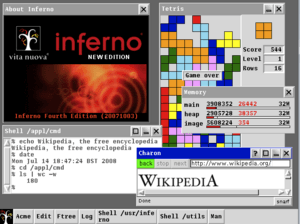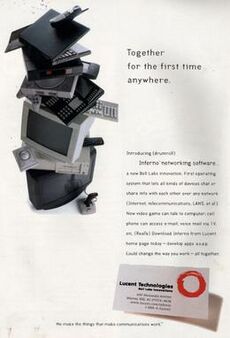Inferno (operating system) facts for kids

Inferno 4th Edition
|
|
| Company / developer | Bell Labs, Vita Nuova Holdings |
|---|---|
| Programmed in | C, Limbo |
| Working state | Discontinued |
| Source model | Open-source |
| Initial release | 1996 |
| Latest stable release | 4th Edition / March 28, 2015 |
| Available language(s) | English |
| Supported platforms | ARM, PA-RISC, MIPS, PowerPC, SPARC, x86 |
| Kernel type | Virtual machine (Dis) |
| License | 2021: MIT 2005: Dual 2003: Dual 2000: Inferno Original: Proprietary |
Inferno is a special kind of operating system that can work across many different computers and networks. It was first created at Bell Labs, a famous research company. Now, a company called Vita Nuova Holdings helps keep it updated. Inferno is available as free software, which means people can use and change its code.
The name "Inferno" and many of its programs were inspired by a famous old Italian book called Divine Comedy by Dante Alighieri. In that book, "Inferno" means "hell".
Contents
What Makes Inferno Special?
Inferno was designed in 1995 to bring new ideas from an older operating system, Plan 9 from Bell Labs, to more devices and networks. It's built on three main ideas:
- Everything is a file: Imagine all the parts of a computer, like its memory or network connections, being treated like files in a folder system. This makes them easy to manage.
- One big view: Inferno lets programs see all the computer's resources, whether they are on your device or far away on the internet, as if they are all in one place.
- Standard way to talk: It uses a special language called Styx for all parts of the system to communicate. This makes it easy for different parts to work together.
How Inferno Works Across Devices
To make Inferno work on many different types of computers and networks, its creators used a virtual machine (VM). A virtual machine is like a pretend computer inside your real computer. It allows programs to run the same way, no matter what kind of device they are on.
Inferno's virtual machine is called Dis. It's designed to be very efficient, even on devices with small amounts of memory. This means Inferno can run on many different kinds of hardware, from small devices to powerful computers.
The main part of Inferno, called the kernel, includes this virtual machine. It also handles tasks like scheduling programs, managing devices, and keeping track of how programs see the computer's files.
Running Everywhere: Inferno's Portability
Inferno was made to be very flexible. It can run on many different types of computer processors, like ARM, MIPS, PowerPC, SPARC, and x86.
It can also run in different ways:
- As a stand-alone operating system on small devices.
- As a program running inside other operating systems like Plan 9, Microsoft Windows, Unix, Linux, and Mac OS X.
No matter where it runs, Inferno programs always see the same setup. This makes it easy for developers to create programs that work everywhere without needing to change them.
Inferno programs are written in a special language called Limbo. Programs written in Limbo are turned into "bytecode" that the Dis virtual machine can understand. This bytecode works on all Inferno platforms without changes.
Key Features
Inferno can run directly on computer hardware or as an application on top of other operating systems like Linux, Windows, and Mac OS X. It supports common computer processors such as Intel x86, ARM, and PowerPC.
Programs for Inferno are written in the Limbo programming language. Limbo helps prevent common programming mistakes and manages memory automatically. Limbo code is turned into a special code called "bytecode" that the Dis virtual machine runs. This means programs work the same way on different computers.
All parts of Inferno, like devices and network connections, are treated like files. You can open, read, and write to them just like regular files. Inferno uses the Styx protocol to talk to both local and remote resources in the same way.
For security, Inferno keeps programs separate from each other. It also has ways to check who is allowed to use resources and can encrypt data to keep it safe.
Inferno also includes tools for creating new programs, like a compiler and a debugger. It can run well even on computers with as little as 1 MB of memory.
History of Inferno
Inferno is like a younger sibling to Plan 9 from Bell Labs. They share many ideas and even some of their basic code, especially how they handle devices and communication. Many of the command-line tools in Inferno were originally from Plan 9 and were rewritten for Inferno.
In the mid-1990s, Bell Labs started focusing more on Inferno than on Plan 9. The new system was first mentioned in early 1996 and was officially shown later that year as a competitor to Java, another programming platform.
In 1997, an advertisement for Inferno showed how different devices could communicate using it. It suggested that video games could talk to computers, cell phones could get email, and even voicemails could be accessed through a TV.
Lucent Technologies, the company that owned Bell Labs, used Inferno in some of its own products. They tried to sell licenses for Inferno's code but didn't find many buyers. Around the same time, Sun Microsystems was heavily promoting its Java programming language, which was similar to Inferno in its goals. Lucent even licensed Java from Sun, planning to make all Inferno devices run Java. However, Inferno still struggled to find customers.
After three years, the Inferno business unit at Lucent closed down. It was then sold to Vita Nuova Holdings. Vita Nuova continued to develop Inferno and offered it for sale. They also made free versions available, though some parts like the core system were not fully open source at first.
In 2005, Inferno's 4th edition was released as free software. This meant different parts of the system were covered by various free software licenses. Then, in March 2021, all editions of Inferno were re-released under the MIT License, which is a very open and free software license.
Inferno's Journey: Key Releases
| Date | Release | What happened |
|---|---|---|
| 1996 | Inferno Beta | First version released by Bell Labs |
| May 1997 | Inferno Release 1.0 | More stable version |
| July 1999 | Inferno 2nd Edition | Released by Lucent's Inferno Business Unit |
| June 2001 | Inferno 3rd Edition | Released by Vita Nuova |
| 2004 | Inferno 4th Edition | Released as open source; many changes were made |
Where Inferno Runs
Inferno can run directly on computer hardware or as a virtual operating system inside other platforms. This means programs can be developed and run on any Inferno platform without needing changes.
It runs directly on processors like: x86, MIPS, ARM, PowerPC, and SPARC.
It can also run as a program on top of other operating systems, including: Microsoft Windows, Linux, FreeBSD, Plan 9, Mac OS X, Solaris, and IRIX.
Inferno has also been adapted to run on devices like Openmoko phones, the Nintendo DS gaming console, and Android devices.
Inferno 4th edition became available as free software in early 2005. This meant people could get it under different free software licenses or a special commercial license. Different parts of the system had different licenses, including the GNU General Public License, the GNU Lesser General Public License, and the MIT License.
In March 2021, all versions of Inferno were re-released mainly under the MIT License. This made it even easier for people to use and share the software freely.
See also
 In Spanish: Inferno (sistema operativo) para niños
In Spanish: Inferno (sistema operativo) para niños
- Language-based system
- Singularity (operating system)


